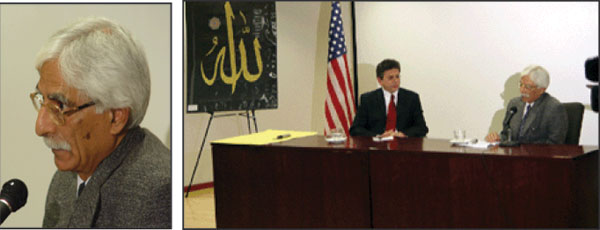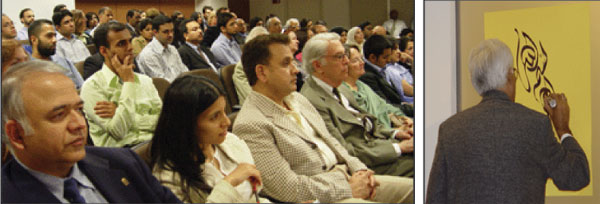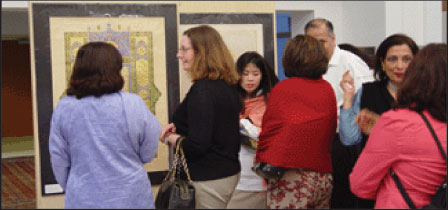Impressive Calligraphy
Exhibition in Washington
By Aisha Chapra
 Rasheed Butt talks about
calligraphy. On his right is DCM Mohammad Sadiq
Rasheed Butt talks about
calligraphy. On his right is DCM Mohammad Sadiq
|
On the evening of May 19 master
calligrapher, Rasheed Butt, opened an exhibition of his works
with a talk on the art of calligraphy at the Embassy of Pakistan.
Deputy Chief of Mission, Mohammad Sadiq introduced Mr. Butt
as not only an artist but “a philosopher”. Mr.
Butt’s art is unique and exquisite, displaying the beauty
of classic Islamic art. He is the president of Pakistan’s
Calligraphy Association and a Jury Member of the International
Calligraphy Competition in Istanbul, Turkey. Mr. Butt has
spent over 40 years practicing the art of classic calligraphy.
In his works he has revived the practice of illumination from
the tenth century and he is the most prominent and world-renowned
professional calligrapher from Pakistan.
Mr. Butt thanked the over-flowing auditorium of guests and
admirers for “sparing the time to see the glorious Islamic
art”. In a brief history of calligraphy, he described
how it was developed into an art form. At the inception of
Islam only a handful of people could read or write. To spread
the message of the Almighty, the Qu’ran had to be written.
This marked the beginning of the art of Islamic calligraphy.
During the rule of Hazrat Ali the tradition to “illuminate
and illustrate the Qur’an” in stylized script
was started. The Kufic style was developed in the city of
Kufa, the capital of the Muslim world in 656 AD. Kufa for
two centuries was one of the leading centers for Muslim theology,
for Arabic grammar, philology, literary criticism, and literature.
Ibn-i-Mughul, a minister and scholar created six different
scripts of calligraphy during this century, including Naskh,
which is still used today to write the Qur’an. Naskh
was the script created to spread the message of the Almighty
and it was one of the earliest to develop.
 A
section of the audience Drawing
Bismillaah ur Rahman ur Rahim
A
section of the audience Drawing
Bismillaah ur Rahman ur Rahim |
In the eighth century a new
script, Nastaleeq or Khat Al Farsi, was developed in Baghdad.
The tradition to create new calligraphic styles continued
over the centuries. According to Mr. Butt the golden era of
Islamic calligraphic art was during “the Ottoman, the
Mughal and the Sufavid empires”.
In Pakistan, Mr. Butt explained, there tend to be mainly commercial
calligraphers, instead of professional calligraphers. However,
in the recent years there has been a surge in support of Islamic
art. He particularly mentioned the Secretary General of the
OIC (Organization of Islamic Conference), Prof. Dr., Ekmeleddin
Ihsanoglu as the greatest supporter and promoter of Islamic
Art. He has worked towards advancing calligraphy and calligraphers
around the world.
Mr. Butt laughingly said that when people see his work the
most often asked question is, “How long did it take
you to make this?” He said it is because most people
become captivated by the intricacy and aesthetic beauty of
the design and forget that calligraphy has literal meaning.
Mr. Butt disclosed that currently he is working on representing
this era through his art. “I have an absolute belief
that Almighty chose me to write his words”. He feels
his work is serious and sacred — the texts he chooses
must be a message to all of mankind, not just Muslims. Mr.
Butt gave an example of such a message from the Qur’an
and it was translated to “He who helps humanity, his
name cannot be removed from this earth”. Mr. Butt believes
that through the appeal of Islamic art, which goes beyond
divisions of faith, ethnicities and race, it can effectively
battle the negative perceptions of Muslims since 9/11.
He finished his talk by telling the audience his philosophy
on the purpose of life. The first purpose is to pray to Almighty
and the second is the exploration of the universe.
 A group of guests at the exhibition
A group of guests at the exhibition |
Then, in an incredible display
of his talent and his expertise, Mr. Butt drew Bismallah ur
Rahman ur Rahim (In the name of Allah, most gracious, most
merciful) in less than three minutes in two different calligraphic
styles. The audience responded with spontaneous applause in
awe of the beauty Mr. Butt created simply with a marker on
a poster. After the display, the audience became engaged and
people started asking questions about the technical aspects
of calligraphy. Mr. Butt told the audience that each calligraphic
script has a different science of proportion. It has taken
Mr. Butt years to study and perfect the various styles of
classic calligraphy.
Questions were asked about the paper and ink he uses to create
his calligraphies. Mr. Butt explained that making his own
paper would take up to two years and that is why he buys the
best paper available in the market. Mr. Butt said he believes
that life is unpredictable and time is of essence, so he must
finish his work representing this era for the upcoming generations
as soon as he could. Thus, he does not take the time to make
his own paper or ink.
Finally, Mr. Butt was asked how he plans to pass on his knowledge
to future generations. “For three years I taught calligraphy
through television, and through that I have millions of students
— my students write to me, send in their calligraphies
and I share with them my knowledge and knowledge of other
calligraphers around the world.”
The exhibition opened in the Jamshed Marker Hall at the Embassy
of Pakistan. It attracted people of all ages and ethnicities.
The exhibition was a remarkably beautiful display of Islamic
art. Mr. Butt’s works’ aesthetic value cannot
be put into words. The guests at the exhibition witnessed
the splendor and glory of each of his calligraphies. Pictures,
some of them included in this article, cannot do them justice.
-------------------------------------------------------------------------------------

